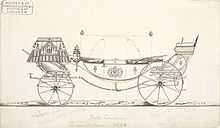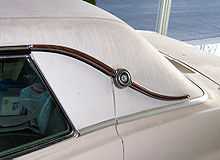Landau (automobile)



Landau, when used in referencing an automobile, generally means a simulated convertible.
History
Landau is originally a coachbuilding term for a type of carriage; see Landau (carriage). Many coachbuilding terms transferred over to automobile usage, since coachbuilders began making motor car bodies instead, and because customers were familiar with coachbuilding terms.
The landau, however, was not a style that transferred well to the automobile. A forward view was generally insisted upon by passengers, so the half-landau (landaulet) style became a more popular choice than the true landau. The landaulet opens over the rear seats, but not the front. Some of these vehicles were inaccurately described as "landaus" while some models with landau bars were falsely conveying the impression that it was a convertible coupe.[1]
The Society of Automotive Engineers (SAE International) defined the landau closed-type body with provision for opening or folding the rear quarter, by use of landau joints which precludes the use of quarter glass.[2] In the 1920s and 1930s, especially in the United States, "landau" became associated with a simulated convertible, in which a fixed roof of a sedan with solid rear quarters was covered with fabric or leather and fitted with S-shaped side landau bars to make it appear like a convertible top.[3] This became the commonly accepted definition of "landau" in North American marketing usage.
After World War II, the term fell into disuse. However, landau became a model name when Nash Motors introduced the Rambler in 1950.[4] The new compact car was available during its first year of production only as a "convertible landau".[5] The Rambler's canvas top opened from the windshield header all the way to the back and stowed in the trunk area. This unique convertible design featured steel framed roof rails called a "bridge beam" around the car's doors and side windows.[6] The Rambler's strong body structure eliminated the internal bracing that was normally needed on other open cars.[5] Essentially it was a cabrio coach.
The term was also used to describe hardtop (pillarless) body designs during the late-1950s.[7]
The landau description was revived during the 1960s. There was a trend for making "fake convertibles" by applying vinyl roofs on regular cars. Some of these vehicles were called "landaus" by their manufacturers, and many were fitted with landau bars on the rear quarters (faux cabriolet).[3] Some used the term "Town Landau" such as for one of the 1967 models in the Ford Thunderbird line.[8] This generally meant a wider rear pillar with no rear quarter windows, or a partial vinyl roof that was applied only over the rear seat area (and is thus reminiscent of a town car).
A landau roof is also commonly used on the North American hearse; very long closed rear quarters, a vinyl roof, and huge, polished landau bars have been the preferred hearse style since before World War II.[9]
References
- ↑ Locke, William S. (2007). Elcar and Pratt automobiles: the complete history. Mcfarland. p. 87. ISBN 9780786432547. Retrieved 3 April 2014.
- ↑ S.A.E. Handbook. Society of Automotive Engineers. 1935. p. 730. Retrieved 3 April 2014.
- ↑ 3.0 3.1 The Merriam-Webster new book of word histories. Merriam-Webster. 1991. p. 359. ISBN 9780877796039. Retrieved 3 April 2014.
- ↑ Flory, Jr., J. Kelly (2008). American Cars, 1946-1959: Every Model, Year by Year. McFarland. pp. 295–298. ISBN 9780786452309. Retrieved 3 April 2014.
- ↑ 5.0 5.1 "Rambler". Automobile Quarterly 33 (2): 33. 1994.
- ↑ Gunnel, John (2004). Standard Guide to 1950s American Cars. Krause Publications. pp. 162–163. ISBN 9780873498685. Retrieved 3 April 2014.
- ↑ "1957 New Car parade: Chrysler family makes debut". Popular Mechanics 106 (5): 104. November 1956. Retrieved 3 April 2014.
- ↑ Gunnell, John. American Cars of the 1960s: A Decade of Diversity. Krause Publications. p. 87. ISBN 9780896891319. Retrieved 3 April 2014.
- ↑ Schechter, Harold (2009). The Whole Death Catalog: A Lively Guide to the Bitter End. Ballantine Books. p. 119. ISBN 9780345512512. Retrieved 3 April 2014.
- Haajanen, Lennart W. Illustrated dictionary of automobile body styles. McFarland. ISBN 978-0-7864-1276-1.